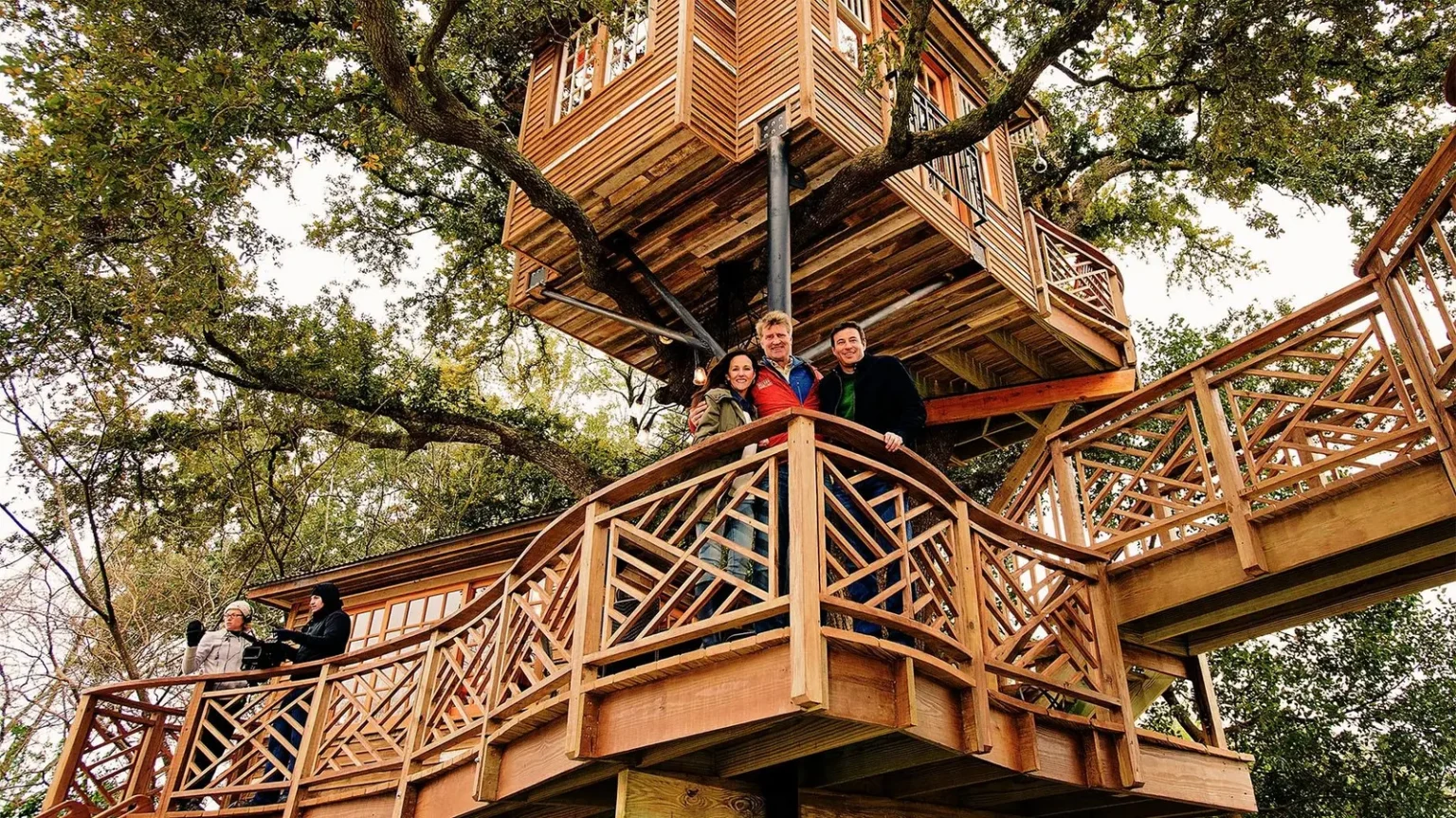America’s Chicken Finger King and His Magical Treehouse Retreat
In the sprawling backyard of Todd Graves’ Baton Rouge estate stands a marvel that transcends ordinary childhood dreams. “It’s fun to have things that are magical,” says the Raising Cane’s Chicken Fingers founder as he relaxes in what might be America’s most extraordinary treehouse. Nestled in a 100-foot live oak tree, this three-level structure cost approximately $400,000 when built in 2015—roughly the price of an average American home. But this is no simple kids’ playhouse; it’s a fully realized retreat befitting the billionaire restaurateur who built a fast-food empire from scratch. The treehouse features 450 square feet of outdoor deck space and 400 square feet of living quarters, complete with a family room, spacious bedroom, and functioning half-bathroom. Its thoughtful details include a pine ceiling made from reclaimed wood from an old sewing factory, a well-stocked bar, and a stained-glass window salvaged from New Orleans after Hurricane Katrina. A disco ball hangs in the skylight above the bed—a playful nod to the decor found in his 900-plus restaurants across the country. Perhaps most impressive is the 70-foot, Ewok-style swinging bridge that connects to a lakefront viewing platform overlooking Louisiana State University’s campus.
The treehouse represents more than just an extravagant backyard feature for Graves. It embodies his lifelong passion for creating special spaces, inspired by the simpler treehouses and forts he built as a child. To bring this vision to life, he collaborated with Pete Nelson of Nelson Treehouse and Supply, whose Washington State-based company featured the project—their largest at the time—in a 2015 episode of Animal Planet’s “Treehouse Masters.” While the $400,000 price tag (equivalent to about $550,000 today) might seem excessive, it represents less than 0.002% of Graves’ estimated $22 billion fortune. The treehouse sits between his main residence and a 5,000-square-foot guest house, creating a private sanctuary where Graves can escape the pressures of running his fast-food empire. “I can come out here and I can think, clear my head,” the 53-year-old entrepreneur explains. “It makes me better at Raising Cane’s.”
What began as a playspace for Graves’ two children and neighborhood kids has evolved into an unexpected celebrity hotspot. As Graves devotes significant time to promoting the Cane’s brand alongside famous personalities, the treehouse has hosted an impressive roster of A-list visitors. Rapper Nelly, NFL star Ja’Marr Chase, and basketball legend Shaquille O’Neal have all enjoyed its unique charm. In fact, O’Neal was so captivated by his visit that he commissioned Nelson to build him a speakeasy-themed treehouse of his own in Georgia. “You can go to someone’s house,” Graves notes with pride, “but there aren’t a lot of treehouses like this you can go hang out in.” Even Snoop Dogg, when performing in Baton Rouge, made a point to visit the treehouse before his show. The rapper’s affection for Graves is evident: “Todd is family to me,” Snoop says simply. Between these celebrity encounters and the continued reruns of the “Treehouse Masters” episode featuring his arboreal retreat, Graves believes he’s actually turned a profit on his $400,000 investment.
The treehouse represents just one facet of Graves’ passion for extraordinary possessions with compelling stories behind them. His own life narrative reads like an adventure novel—when no financial institution would fund his concept for a restaurant serving only chicken fingers, Graves took matters into his own hands. He worked dangerous jobs as a boilermaker and Alaskan salmon fisherman to save the money needed to launch his first restaurant. This determined bootstrap approach eventually transformed him into America’s wealthiest restaurateur and positioned him among the nation’s 50 richest individuals. With his chicken finger fortune, Graves has assembled an eclectic collection of treasures that speak to his love of history and storytelling: a 66-million-year-old triceratops skeleton, Harrison Ford’s iconic jacket from Raiders of the Lost Ark, and a pair of Elvis Presley’s sunglasses. His enthusiasm for collecting remains undiminished—”I just won a bid on one of Napoleon’s hats today,” he reveals while gazing across his property from the treehouse’s 35-foot-high deck.
The treehouse embodies Graves’ philosophy that environments should inspire creativity and joy. Every element of the structure was carefully considered—from the practical amenities like running water and electricity to whimsical touches like the disco ball that casts dancing lights across the bedroom at night. The salvaged materials throughout tell stories of their own: the reclaimed wood carries the history of an industrial past, while the stained glass and bar fixtures represent resilience after disaster. These narrative elements resonate with Graves, whose own business was built on perseverance through hardship. The treehouse serves multiple purposes in his life—a place for solitude and reflection, family bonding, entertaining distinguished guests, and occasionally, a unique setting for business discussions away from corporate boardrooms. Standing on one of the expansive decks as sunlight filters through the ancient oak’s branches, visitors experience the same sense of wonder that inspired Graves to create this extraordinary retreat.
Graves’ treehouse also reflects a broader trend among ultra-wealthy entrepreneurs who seek to create personalized spaces that transcend conventional luxury. While some billionaires build mega-yachts or private islands, Graves chose to invest in something that connects him to his childhood imagination while providing a distinctive gathering place. The treehouse has become part of his personal brand story—an extension of the Raising Cane’s ethos that values quality, creativity, and community. It serves as a physical manifestation of his success story: from being rejected by banks and working dangerous jobs to fund his dream, to creating a fast-food empire that has made him billions. When celebrities visit and share their experiences through social media, the treehouse becomes part of the Raising Cane’s mystique, reinforcing Graves’ reputation as an unconventional business leader who values experiences over traditional symbols of wealth. As he puts it while surveying his estate from his perch among the oak branches, these magical touches throughout his life “keep me dreaming, man.”
For Graves, the treehouse represents something far more significant than an expensive plaything—it embodies the childlike wonder and imagination that he’s carried into his business life. This blend of playfulness and serious entrepreneurship defines his approach to building the Raising Cane’s brand, which has expanded from a single location near Louisiana State University to a nationwide phenomenon. The treehouse stands as a physical reminder that success doesn’t mean abandoning what brings joy; rather, it provides the freedom to elevate those simple pleasures to extraordinary heights. As twilight descends over Baton Rouge, lights illuminate the structure from within, making it glow like a lantern among the oak’s massive branches. Graves often finds himself here in these quiet moments, reflecting on the journey that took him from rejected loan applicant to billionaire businessman. The treehouse—with its blend of whimsy, craftsmanship, and practicality—perfectly encapsulates the spirit that drove Graves to create America’s chicken finger empire: a belief that even the simplest ideas, when pursued with passion and executed with excellence, can transform into something magical.















